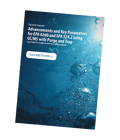Separation Science, in collaboration with Agilent, offers an on-demand webinar featuring presentations describing advancements and key parameters for EPA 8260 and EPA 524.2 using GC/MS with purge and trap technology.
Duration: Approx. 50 minutes
Presenters:
 Joel Kelly
Joel Kelly
(Pace Analytical)
Joel has been working in the IDEA Lab for Pace Analytical for the last two years and spent fourteen years in the environmental testing industry focusing mostly on organic chemistries. Currently he evaluates new technology, develops new methods and focuses on efficiency advancement for Pace Analytical.
 Bruce Quimby, Ph.D.
Bruce Quimby, Ph.D.
(Senior Applications Scientist, Agilent)
Dr Bruce Quimby is a Senior Applications Scientist in the Mass Spectrometry Division of Agilent Technologies, located in Wilmington, Delaware. He is currently working in GC/MS applications in multiple areas including environmental and food safety.
Sponsor

 All registrants to this on-demand presentation will also be able to download their personal copy of the complementary 'Executive Summary', a comprehensive technical overview of both presentations.
All registrants to this on-demand presentation will also be able to download their personal copy of the complementary 'Executive Summary', a comprehensive technical overview of both presentations.